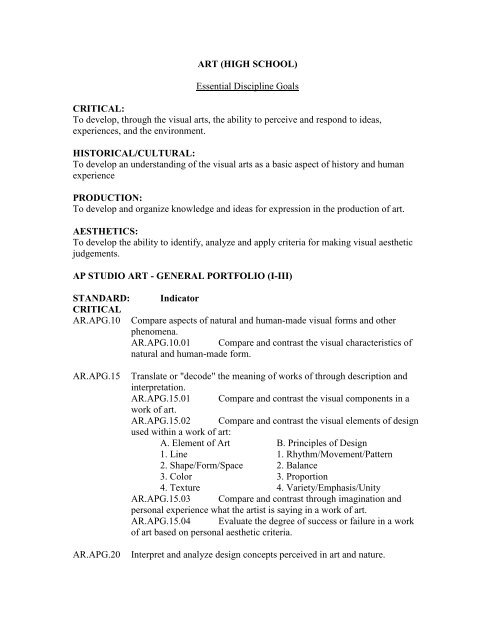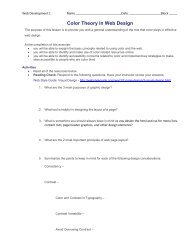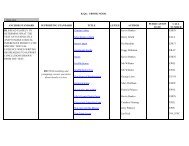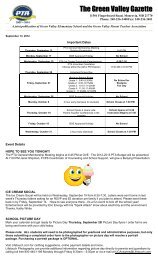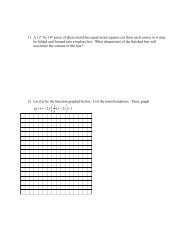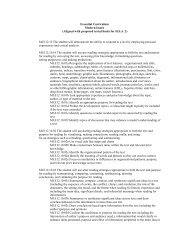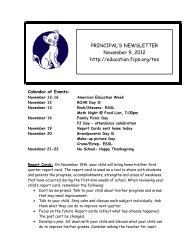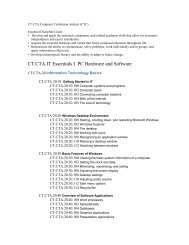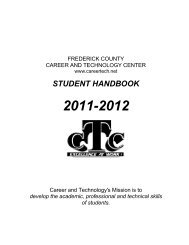AP Studio Art I-III - Middletown High School
AP Studio Art I-III - Middletown High School
AP Studio Art I-III - Middletown High School
You also want an ePaper? Increase the reach of your titles
YUMPU automatically turns print PDFs into web optimized ePapers that Google loves.
ART (HIGH SCHOOL)<br />
Essential Discipline Goals<br />
CRITICAL:<br />
To develop, through the visual arts, the ability to perceive and respond to ideas,<br />
experiences, and the environment.<br />
HISTORICAL/CULTURAL:<br />
To develop an understanding of the visual arts as a basic aspect of history and human<br />
experience<br />
PRODUCTION:<br />
To develop and organize knowledge and ideas for expression in the production of art.<br />
AESTHETICS:<br />
To develop the ability to identify, analyze and apply criteria for making visual aesthetic<br />
judgements.<br />
<strong>AP</strong> STUDIO ART - GENERAL PORTFOLIO (I-<strong>III</strong>)<br />
STANDARD: Indicator<br />
CRITICAL<br />
AR.<strong>AP</strong>G.10 Compare aspects of natural and human-made visual forms and other<br />
phenomena.<br />
AR.<strong>AP</strong>G.10.01 Compare and contrast the visual characteristics of<br />
natural and human-made form.<br />
AR.<strong>AP</strong>G.15 Translate or "decode" the meaning of works of through description and<br />
interpretation.<br />
AR.<strong>AP</strong>G.15.01 Compare and contrast the visual components in a<br />
work of art.<br />
AR.<strong>AP</strong>G.15.02 Compare and contrast the visual elements of design<br />
used within a work of art:<br />
A. Element of <strong>Art</strong> B. Principles of Design<br />
1. Line 1. Rhythm/Movement/Pattern<br />
2. Shape/Form/Space 2. Balance<br />
3. Color 3. Proportion<br />
4. Texture 4. Variety/Emphasis/Unity<br />
AR.<strong>AP</strong>G.15.03 Compare and contrast through imagination and<br />
personal experience what the artist is saying in a work of art.<br />
AR.<strong>AP</strong>G.15.04 Evaluate the degree of success or failure in a work<br />
of art based on personal aesthetic criteria.<br />
AR.<strong>AP</strong>G.20 Interpret and analyze design concepts perceived in art and nature.
AR.<strong>AP</strong>G.20.01 Apply the following design concepts to interpret<br />
and analyze art and nature<br />
A. Element of <strong>Art</strong> B. Principles of Design<br />
1. Line 1. Rhythm/Movement/Pattern<br />
2. Shape/Form/Space 2. Balance<br />
3. Color 3. Proportion<br />
4. Texture 4. Variety/Emphasis/Unity<br />
HISTORICAL/CULTURAL<br />
AR.<strong>AP</strong>G.25 Select and analyze works of various artists which record, preserve,<br />
highlight, and symbolize cultural ideas.<br />
AR.<strong>AP</strong>G.25.01 Explore artistic styles from various periods in art<br />
history.<br />
AR.<strong>AP</strong>G.25.02 Explore visual characteristics of multi-cultural<br />
styles and symbols in art through observation and analysis.<br />
AR.<strong>AP</strong>G.25.03 Compare and contrast ways specific moods or<br />
feelings reflect cultural/historical ideas.<br />
AR.<strong>AP</strong>G.30 Determine how specific societies are reflected in and changed by works of<br />
art.<br />
AR.<strong>AP</strong>G.30.01 Compare and contrast how societies use art to<br />
communicate and express their culture.<br />
AR.<strong>AP</strong>G.30.02 Compare and contrast the impact art works have on<br />
their society through research, discussion, and observation.<br />
AR.<strong>AP</strong>G.35 Recognize the relationship between the choices an artist makes and the<br />
society or context in which he/she works.<br />
AR.<strong>AP</strong>G.35.01 Analyze the impact on what artists produce<br />
and the aesthetic values society places on them.<br />
AR.<strong>AP</strong>G.40 Recognize the influences of art on technology and technology on the arts.<br />
AR.<strong>AP</strong>G.40.01 Survey technology from the artist's viewpoint.<br />
PRODUCTION<br />
AR.<strong>AP</strong>G.45 Use a variety of art tools, materials, and techniques to solve specific art<br />
problems.<br />
AR.<strong>AP</strong>G.45.01 Create and illustrate works of art that demonstrate<br />
proficient use of a variety of tools and materials for the following areas:<br />
drawing diagrams/plans<br />
painting animation<br />
photography sculpture<br />
typography fiber arts<br />
ceramics jewelry<br />
furniture<br />
computer graphics/graphics/printmaking
collage/montage/mixed media<br />
architecture/industrial design<br />
AR.<strong>AP</strong>G.45.02 Create and illustrate works of art that demonstrate<br />
proficiency in techniques:<br />
additive (sculpture)<br />
subtractive (sculpture)<br />
line and tone<br />
spatial illusion<br />
typographical organization<br />
repeated pattern/modular design<br />
AR.<strong>AP</strong>G.50 Apply knowledge acquired in a variety of contexts to the creation of visual<br />
images.<br />
AR.<strong>AP</strong>G.50.01 Create a portfolio that includes the following<br />
structured sections:<br />
1. quality<br />
2. concentration<br />
3. breadth<br />
AR.<strong>AP</strong>G.50.02 Integrate and illustrate the production skills and<br />
techniques used in the development of specific works in the following<br />
areas:<br />
spatial relationship<br />
psychological space/time and space<br />
social commentary<br />
attitudinal expressions<br />
historical relationships<br />
imagination of dreams and fantasies<br />
cultural interpretations<br />
AR.<strong>AP</strong>G.50.03 Create a work of art that combines two different<br />
disciplines and that integrate skills from both.<br />
AR.<strong>AP</strong>G.50.04 Combine a variety of concrete or abstract<br />
objects/materials/artwork in an experimental fashion to produce a creative<br />
solution.<br />
AR.<strong>AP</strong>G.55 Apply specific design concepts to solve problems of composition.<br />
AR.<strong>AP</strong>G.55.01 Compose works of art that solve the following<br />
problems in composition in 2D or 3D artworks:<br />
perspective<br />
positive/negative spatial relationships and illusion<br />
figure-ground relationship<br />
metamorphosis or transformation<br />
series<br />
abstract enlargement<br />
color theory<br />
color organization<br />
transparency
symbolic color<br />
color effects (rhythm)<br />
emotional color<br />
repeated pattern/modular design<br />
line and tone<br />
figurative/non-figurative<br />
AR.<strong>AP</strong>G.60 Develop a responsible attitude toward oneself and others through<br />
continuing compliance with health and safety rules.<br />
AR.<strong>AP</strong>G.60.01 Investigate the safety precautions and health<br />
standards associated with 2D and 3D art.<br />
AR.<strong>AP</strong>G.60.02 Demonstrate a responsible attitude that promotes<br />
safe use of all art supplies.<br />
AESTHETICS<br />
AR.<strong>AP</strong>G.65 Evaluate a variety of visual forms through analysis and discussion in order<br />
to make judgments.<br />
AR.<strong>AP</strong>G.65.01 Investigate design concepts of an observed scene in<br />
the environment.<br />
AR.<strong>AP</strong>G.65.02 Apply criteria used for aesthetic judgment.<br />
AR.<strong>AP</strong>G.65.03 Critique artwork using the concepts of design to<br />
determine the degree of success or failure.<br />
AR.<strong>AP</strong>G.70 Apply aesthetic criteria in critiquing selected art works.<br />
AR.<strong>AP</strong>G.70.01 Compare and contrast the effect of different styles<br />
or techniques on individual artistic expression.<br />
AR.<strong>AP</strong>G.70.02 Apply the criteria used for the selection of works of<br />
art within an exhibition.<br />
AR.<strong>AP</strong>G.70.03 Select and curate an exhibition that implements the<br />
aesthetic criteria.<br />
AR.<strong>AP</strong>G.75 Assess one’s own aesthetic framework and modify one’s work<br />
accordingly.<br />
AR.<strong>AP</strong>G.75.01 Apply criteria used for selecting work for a<br />
portfolio or exhibition.<br />
AR.<strong>AP</strong>G.75.02 Apply the identified aesthetic criteria to critique<br />
one’s own art work.
Essential Discipline Goals<br />
ART (HIGH SCHOOL)<br />
CRITICAL: To develop, through the visual arts, the ability to perceive<br />
and respond to ideas, experiences, and the environment.<br />
HISTORICAL/CULTURAL: To develop an understanding of the visual arts as a basic<br />
aspect of history and human experience<br />
PRODUCTION: To develop and organize knowledge and ideas for<br />
expression in the production of art.<br />
AESTHETICS: To develop the ability to identify, analyze and apply criteria<br />
for making visual aesthetic judgments.<br />
<strong>AP</strong> <strong>Studio</strong> - Drawing Portfolio (I-<strong>III</strong>)<br />
STANDARD Indicators<br />
CRITICAL<br />
AR.<strong>AP</strong>D.10 Compare aspects of natural and human-made visual forms and other<br />
phenomena.<br />
AR.<strong>AP</strong>D.10.01 Compare and contrast the visual characteristics of<br />
natural and human-made form.<br />
AR.<strong>AP</strong>D.15 Translate or "decode" the meaning of works of through description and<br />
interpretation.<br />
AR.<strong>AP</strong>D.15.01 Compare and contrast the visual components in a<br />
work of art.<br />
AR.<strong>AP</strong>D.15.02 Compare and contrast the visual elements of design<br />
used within a work of art:<br />
A. Elements of <strong>Art</strong> B. Principles of Design<br />
1. Line 1. Rhythm/Movement/Pattern<br />
2. Shape/Form/Space 2. Balance<br />
3. Color 3. Proportion<br />
4. Texture 4. Variety/Emphasis/Unity<br />
AR.<strong>AP</strong>D.15.03 Compare and contrast through imagination and<br />
personal experience what the artist is saying in a work of art.<br />
AR.<strong>AP</strong>D.15.04 Evaluate the degree of success or failure in a work<br />
of art based on personal aesthetic criteria.<br />
AR.<strong>AP</strong>D.20 Interpret and analyze design concepts perceived in art and nature.<br />
AR.<strong>AP</strong>D.20.01 Apply the following design concepts to interpret<br />
and analyze art and nature.<br />
A. Element of <strong>Art</strong> B. Principles of Design<br />
1. Line 1. Rhythm/Movement/Pattern<br />
2. Shape/Form/Space 2. Balance<br />
3. Color 3. Proportion
HISTORICAL/CULTURAL<br />
4. Texture 4. Variety/Emphasis/Unity<br />
AR.<strong>AP</strong>D.25 Select and analyze works of various artists which record, preserve,<br />
highlight, and symbolize cultural ideas.<br />
AR.<strong>AP</strong>D.25.01 Explore artistic styles from various periods in art<br />
History.<br />
AR.<strong>AP</strong>D.25.02 Explore visual characteristics of multi-cultural<br />
styles and symbols in art through observation, and analysis.<br />
AR.<strong>AP</strong>D.25.03 Compare and contrast ways specific moods or<br />
feelings reflect cultural/historical ideas.<br />
AR.<strong>AP</strong>D.30 Determine how specific societies are reflected in and changed by works of<br />
art.<br />
AR.<strong>AP</strong>D.30.01 Compare and contrast how societies use art to<br />
communicate and express their culture.<br />
AR.<strong>AP</strong>D.30.01 Compare and contrast the impact art works have on<br />
their society through research, discussion, and observation.<br />
AR.<strong>AP</strong>D.35 Recognize the relationship between the choices an artist makes and the<br />
society or context in which he/she works.<br />
AR.<strong>AP</strong>D.35.01 Analyze the impact on what artists produce and the<br />
aesthetic values society places on them.<br />
AR.<strong>AP</strong>D.40 Recognize the influences of art on technology and technology on the arts.<br />
AR.<strong>AP</strong>D.40.01 Survey technology from the artist's viewpoint.<br />
PRODUCTION<br />
AR.<strong>AP</strong>D.45 Use a variety of art tools, materials, and techniques to solve specific art<br />
problems.<br />
AR.<strong>AP</strong>D.45.01 Create and illustrate works of art that demonstrate<br />
proficient use of a variety of tools and materials:<br />
pencils pastel or chalk<br />
conte crayon charcoal<br />
crayon ink or watercolor wash<br />
pen and ink papers/surfaces<br />
brush<br />
AR.<strong>AP</strong>D.50 Apply knowledge acquired in a variety of contexts to the creation of visual<br />
images.<br />
AR.<strong>AP</strong>D.50.01 Create and illustrate works of art that demonstrate<br />
proficiency in techniques:<br />
perspective gesture
contour-line/cross rendering<br />
autotatic drawing 2D assemblages<br />
collage/montage/mixed media/transfer<br />
prints and monoprint<br />
AR.<strong>AP</strong>D.50.02 Create a portfolio that includes the following structured<br />
sections:<br />
1. quality<br />
2. concentration<br />
3. breadth<br />
AR.<strong>AP</strong>D.50.03 Integrate and illustrate the production skills and<br />
techniques used in the development of specific works in the following<br />
areas:<br />
spatial relationship<br />
psychological space/time and space<br />
social commentary<br />
attitudinal expressions<br />
historical relationships<br />
imagination/dreams and fantasies<br />
cultural interpretations<br />
AR.<strong>AP</strong>D.50.04 Create a work of art that combines two different<br />
disciplines and that integrate skills from both.<br />
AR.<strong>AP</strong>D.50.05 Combine a variety of concrete or abstract objects<br />
materials/artwork in an experimental fashion to produce a creative<br />
solution.<br />
AR.<strong>AP</strong>D.55 Apply specific design concepts to solve problems of composition.<br />
AR.<strong>AP</strong>D.55.01 Compose works of art that solve the following<br />
problems in composition:<br />
perspective<br />
positive/negative spatial relationships<br />
figure-ground relationship<br />
metamorphosis or transformation<br />
series<br />
abstract enlargement<br />
AR.<strong>AP</strong>D.55.02 Compare and contrast design concepts used in<br />
works of art.<br />
AR.<strong>AP</strong>D.60 Develop a responsible attitude toward oneself and others through<br />
continuing compliance with health and safety rules.<br />
AR.<strong>AP</strong>D.60.01 Investigate the safety precautions and health<br />
standards associated with the drawing media.<br />
AR.<strong>AP</strong>D.60.02 Demonstrate a responsible attitude that promotes<br />
safe use of all art supplies.<br />
AESTHETICS
AR.<strong>AP</strong>D.65 Evaluate a variety of visual forms through analysis and discussion in order<br />
to make judgments.<br />
AR.<strong>AP</strong>D.65.01 Investigate design concepts of an observed scene in<br />
the environment.<br />
AR.<strong>AP</strong>D.65.02 Apply criteria used for aesthetic judgment.<br />
AR.<strong>AP</strong>D.65.03 Critique artwork using the concepts of design to<br />
determine the degree of success or failure.<br />
AR.<strong>AP</strong>D.70 Apply aesthetic criteria in critiquing selected art works.<br />
AR.<strong>AP</strong>D.70.01 Compare and contrast the effect of different styles<br />
and techniques on individual artistic expression.<br />
AR.<strong>AP</strong>D.70.02 Apply the criteria used for the selection of works of<br />
art within an exhibition.<br />
AR.<strong>AP</strong>D.70.03 Select and curate an exhibition that implements the<br />
aesthetic criteria.<br />
AR.<strong>AP</strong>D.75 Assess one’s own aesthetic framework and modify one’s work<br />
accordingly.<br />
AR.<strong>AP</strong>D.75.01 Apply criteria used for selecting work for a<br />
portfolio or exhibition.<br />
AR.<strong>AP</strong>D.75.02 Apply the identified aesthetic criteria to critique<br />
one’s own art work.


